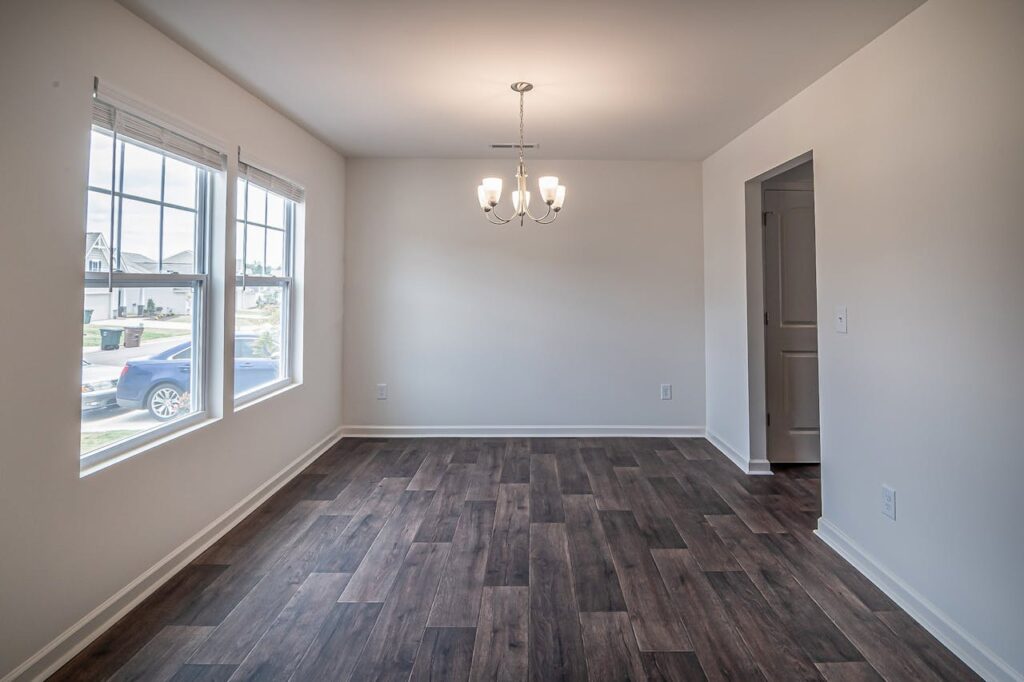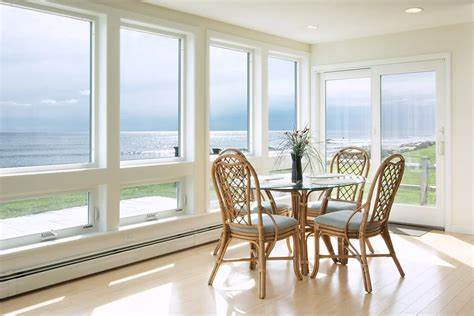Energy-Efficient Window Replacement Rexburg, ID
Energy-Efficient Windows
Energy-efficient windows are specially designed to reduce energy consumption and enhance the comfort of your home or business. These windows feature advanced technologies like Low-E coatings, double or triple glazing, and insulating gas fills between the panes. These elements work together to minimize heat transfer, keeping your indoor spaces warmer in the winter and cooler in the summer. By improving insulation, energy-efficient windows help maintain a stable indoor temperature, which can lead to significant savings on heating and cooling costs.
These windows also offer additional benefits, such as reducing condensation and blocking harmful UV rays that can fade your furniture and carpets. Energy-efficient windows come in various styles and materials, allowing you to choose the best fit for your property’s aesthetics and performance needs. With modern designs and finishes, they can enhance both the appearance and functionality of your windows, making them a smart investment for homeowners and establishment owners alike.
Where to Install Energy-Efficient Windows?
Energy-efficient windows are ideal for any room in your home or business where you want to improve comfort and reduce energy costs. They are particularly beneficial for areas with large windows, such as living rooms, offices, and storefronts, where energy loss can be significant. Whether you’re renovating a historic home or upgrading a modern building, these windows can enhance the energy performance and aesthetic appeal of your property in Rexburg, ID.

Why Choose Energy-Efficient Window Installation

Energy-efficient windows help reduce your energy bills by improving the insulation of your home or business. They keep warm air inside during winter and prevent cool air from escaping in the summer, reducing the need for heating and air conditioning. This efficiency can lead to substantial savings over time, making them a cost-effective upgrade for any property.
These windows create a more comfortable living or working environment by maintaining a consistent indoor temperature. They reduce drafts and cold spots, making your rooms feel cozier in the winter and more refreshing in the summer. Enhanced comfort means you can enjoy your space more without constantly adjusting your thermostat.
Installing energy-efficient windows also helps reduce your carbon footprint by lowering the energy consumption of your property. By using less energy to heat and cool your spaces, you contribute to a reduction in greenhouse gas emissions. This makes energy-efficient windows an environmentally friendly choice that supports sustainable living practices.
Choose the Right Material for Your Energy-Efficient Windows
Vinyl Energy-Efficient Windows
Vinyl windows are made from PVC (polyvinyl chloride), a strong plastic material. They are popular because they are affordable and require little maintenance. Vinyl windows have good insulation properties. They help keep your home warm in winter and cool in summer. These windows do not need painting or staining, and they are resistant to moisture and rot.
Fiberglass Energy-Efficient Windows
Fiberglass windows are constructed from glass fibers and resin. This makes them very strong and durable. They do not warp or crack and can handle extreme weather conditions. Fiberglass windows provide excellent insulation, making your home more energy-efficient. You can paint them to match your style, and they look sleek and modern.
Wood Energy-Efficient Windows
Wood windows are known for their natural beauty and traditional look. They are made from solid wood, which provides good insulation. Wood windows can be stained or painted to fit your home’s decor. While they require more maintenance to protect against moisture and insects, they add a warm, classic touch to your home.
Aluminum Energy-Efficient Windows
Aluminum windows are made from strong, lightweight metal. They are durable and resistant to rust and corrosion. Aluminum windows are a good choice for modern designs because they have slim profiles. They are not as insulating as other materials, but with proper thermal breaks, they can be made more energy-efficient.
Composite Energy-Efficient Windows
Composite windows are made from a mix of materials like wood fibers and PVC. They offer the look of wood but with less maintenance. Composite windows are strong and provide good insulation. They resist weathering and do not warp or rot. These windows combine the benefits of different materials to enhance performance and durability.
Steel Energy-Efficient Windows
Steel windows are made from robust metal, providing exceptional strength. They have slim frames, allowing for larger glass areas and better views. Steel windows are durable and secure, making them suitable for both residential and commercial properties. They can be combined with thermal breaks to improve insulation and energy efficiency.

Your Guide to the Different Types of Energy-Efficient Windows
Double-Pane Replacement Windows
Double-pane windows consist of two layers of glass with a space between them. This space acts as an insulator, reducing heat transfer and making your home or business more energy-efficient. The gap between the panes is often filled with air or an insulating gas to improve thermal performance. Double-pane windows provide better insulation than single-pane windows and can help lower heating and cooling costs while reducing outside noise.
Triple-Pane Replacement Windows
Triple-pane windows have three layers of glass with two insulating spaces between them. This extra layer provides even better insulation than double-pane windows, making them ideal for areas with extreme temperatures. The additional pane enhances the window’s ability to keep warm air in during the winter and cool air in during the summer, offering maximum energy savings. Triple-pane windows are excellent for enhancing comfort and efficiency in both residential and commercial settings.
Low-E Replacement Windows
Low-E (low-emissivity) windows have a special coating on the glass that reflects heat. This coating helps keep your indoor temperature consistent by reflecting heat back into the room during winter and blocking heat from entering in summer. Low-E windows also reduce UV rays, which can prevent fading of your furnishings and floors. These windows are a great choice if you want to improve energy efficiency without compromising on natural light.
Tinted Replacement Windows
Tinted windows have a slight coloring that helps reduce the amount of heat and glare from the sun. They are particularly useful in sunny locations, as they can lower the cooling load and improve comfort by blocking excessive sunlight. Tinted windows also provide some privacy by reducing visibility from the outside while still allowing you to see out. This makes them a practical choice for rooms with large windows that face direct sunlight.
Reflective Replacement Windows
Reflective windows have a metallic coating that reflects sunlight, which helps reduce solar heat gain and glare. These windows are designed to keep interiors cooler by bouncing sunlight away before it can enter your home or business. Reflective windows are especially effective for buildings in hot climates where managing sunlight and heat is crucial. They also add a sleek, modern look to your property while improving energy efficiency.
Gas-Filled Replacement Windows
Gas-filled windows contain an inert gas, like argon or krypton, between the panes instead of regular air. These gases are denser than air, providing better insulation and reducing heat transfer. Gas-filled windows enhance the thermal performance of both double-pane and triple-pane windows, making them more efficient at maintaining indoor temperatures. This type of window is ideal for those looking to maximize energy savings and improve overall comfort.
Frequently Asked Questions About Energy-Efficient Windows
Answer: Energy-efficient windows are designed to reduce heat transfer, keeping your home warmer in winter and cooler in summer. They feature advanced technologies like double or triple glazing, Low-E coatings, and gas fills between panes. These features work together to improve insulation, lower energy use, and enhance indoor comfort.
Answer: Energy-efficient windows save money by reducing your heating and cooling costs. They minimize heat loss in the winter and prevent heat gain in the summer, reducing the need for heating and air conditioning. Over time, the savings on energy bills can offset the initial investment in these windows.
Answer: Low-E (low-emissivity) glass has a special coating that reflects infrared light while allowing visible light to pass through. This coating helps keep heat inside during the winter and outside during the summer. Low-E glass also reduces UV rays, which can prevent fading of furniture and carpets, making it an essential feature for energy-efficient windows.
Answer: Triple-pane windows offer better energy efficiency than double-pane windows because they have an extra layer of glass and additional insulating space. This extra pane improves thermal insulation, making triple-pane windows more effective at reducing heat transfer and noise. However, double-pane windows are still a significant improvement over single-pane windows and can be a more cost-effective option.
Answer: You can check if your current windows are energy-efficient by looking for labels or certifications such as ENERGY STAR®. Additionally, features like double or triple glazing, Low-E coatings, and gas fills indicate energy efficiency. If your windows are old, drafty, or cause high energy bills, they may not be energy-efficient and could benefit from replacement.
Answer: Common gases used in energy-efficient windows are argon and krypton. These gases are denser than air, which improves insulation by reducing heat transfer between panes. Argon is more commonly used and cost-effective, while krypton provides better insulation but is more expensive. Both gases enhance the thermal performance of double-pane and triple-pane windows.
Answer: Yes, energy-efficient windows can reduce noise, especially those with double or triple glazing. The multiple layers of glass and insulating space help block sound from outside. This makes them a good choice for homes or offices in noisy areas, such as near busy streets or airports.
Answer: Energy-efficient windows do not require special maintenance beyond regular cleaning and inspection. Keep the glass clean with a mild soap and water solution, and check seals and weatherstripping for wear. Proper maintenance ensures the windows continue to perform well and remain energy-efficient.
Answer: Energy-efficient windows typically cost more upfront than regular windows due to their advanced features and materials. However, the higher initial cost is often offset by long-term savings on energy bills. The improved comfort and reduced environmental impact also add value to the investment.
Answer: The lifespan of energy-efficient windows depends on the material and quality of installation. Generally, they can last 20 to 30 years with proper maintenance. High-quality windows with durable frames and modern glazing technologies can provide long-term performance, making them a worthwhile investment for your home or business.
Brands & Awards




Contact Us Today
Ready to transform your home with new doors and windows? Contact our team at Ecoview Windows & Doors Rexburg to start your project. Let us help you make your dream home a reality with our expert door installation and window replacement services.
Call us now for a free estimate!
